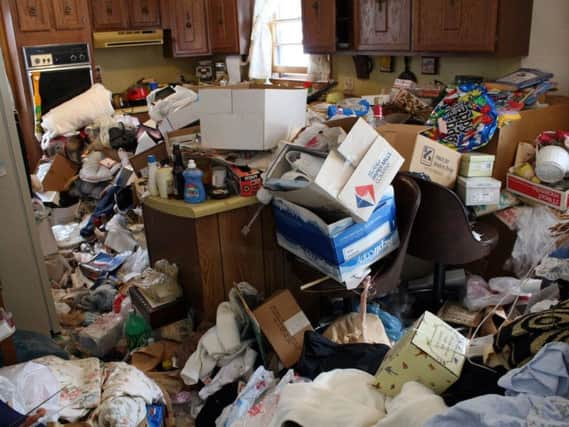REVEALED IN PICTURES: OCD clutter scale will tell you if you have a hoarding problem


CLICK THE LINK ABOVE OR THE GALLERY ICON TO SEE THE OCD CLUTTER SCALE AND FIND OUT IF YOU HAVE A HOARDING PROBLEM
A person is considered to have a problem with hoarding when their home becomes excessively cluttered, when they have problems discarding things, and when it interferes with everyday living – for example preventing safe cooking, going to bed or accessing rooms.
Advertisement
Hide AdAdvertisement
Hide AdHoarding UK has created a series of pictures of rooms in various stages of clutter – from completely clutter-free to very severely cluttered.
People can just pick out the picture in each sequence comes closest to the clutter in their own living room, kitchen, and bedroom.
A spokesman said: “This requires some degree of judgement because no two homes look exactly alike, and clutter can be higher in some parts of the room than others.
“Still, this rating works pretty well as a measure of clutter.
Advertisement
Hide AdAdvertisement
Hide Ad“In general, clutter that reaches the level of picture # 4 or higher impinges enough on people’s lives that we would encourage them to get help for their hoarding problem.”
A support group was started by Karen Lock, a marketing and domestic safety officer at Buckinghamshire Fire and Rescue Service, with Elaine Hassall, a Strategy and Partnerships Officer at Aylesbury Vale District Council in Bucks, and Miami Holt, a Neighbourhood Manager at the Vale of Aylesbury Housing Trust.
This vital service to the community was launched in order to bring hoarders and their families and friends together in a safe, caring and supportive environment to share their experiences.
They meet on a monthly basis and currently have between 12 and 15 people regularly attending.
Advertisement
Hide AdAdvertisement
Hide AdKaren said: “The main issues are isolation and shame – often people who hoard are reluctant to let others into their home.”
Karen, who also volunteers as a bereavement councillor, advocates improving co-operation between organisations to support those with hoarding problems.
It is estimated that more than a million people across the UK have a hoarding disorder which can seriously affect health and well-being, as well as posing a significant risk of fire and infestation.
High levels of clutter in the home make it much easier for a fire to spread and impedes escape routes.
Advertisement
Hide AdAdvertisement
Hide AdThe reasons why someone becomes a hoarder are still not fully understood but people can be more at risk if there is a family history of hoarding or if they are lonely or alcohol dependent.
Contrary to popular belief, hoarders often have stable jobs and are well educated.
Karen confirmed: “We get people of all ages and all types of backgrounds come to see us.”
In May 2013, Hoarding Disorder was officially recognised in the Diagnostic and Statistical Manual of Mental Disorders.
Advertisement
Hide AdAdvertisement
Hide AdAccording to mental health charity MIND, the main treatment for hoarding is Cognitive Behavioural Therapy (CBT), which seeks to change the way a person
thinks by encouraging them to talk about their thoughts and feelings.
Karen says she has observed as much during her meetings, saying “support from just being there can be empowering”.
She added: “There is help out there.
“My hope is that for the future it will get better.”
What is Hoarding?
‘MIND’, the mental health charity defines hoarding as follows:
Hoarding is considered to be a problem when:
Advertisement
Hide AdAdvertisement
Hide Ad> The amount of clutter in the person’s home is increasing
> They bring in more things each day and discard very little
> The amount of clutter interferes with everyday living – for example, they are unable to use the kitchen or bathroom and cannot access rooms